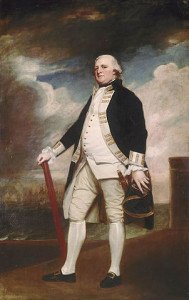Nonsuch v Actif – 14/15 May 1781
Wherever action was to be found in the American War of Independence, there was a strong possibility that Captain Sir James Wallace would be involved. In forcing the apparently impassable Hell s Gate to escape the French fleet off Long Island, battering a French squadron in Cancale Bay, being captured by Admiral Comte d Estaing s fleet, or making a prize of the crack frigate Belle Poule, Wallace had enjoyed an eventful war. Thus when following the relief of Gibraltar his command, the Nonsuch 64, was detached from Vice-Admiral George Darby s Channel fleet in the Bay of Biscay to scout ahead, most of the other captains probably reacted with envy, knowing that action would inevitably come Wallace s way.
It did.
At 8 p.m. on 14 May, about a hundred miles north of Ushant, the Nonsuch sighted three sail and gave chase. These were soon ignored however when a larger vessel was discovered in the east south-east. The stranger would prove to be the French ship of the line Actif 74, Captain Jean Brun de Boades, which had separated from Admiral Toussaint Guillaume La Motte-Picquet s squadron after that force had intercepted the richly-laden England-bound St. Eustatius convoy on 2 May.
The Actif had been launched at Brest in 1757 but had not been commissioned until after the culmination of the Seven Years War, and bar her participation in the capture of the St. Eustatius convoy her only activity of note had been her involvement in the Battle of Ushant. She had a nominal crew of seven hundred and twenty men and boasted an armament of twenty-eight 36-pounder cannon on her lower deck, thirty 18-pounders on her upper deck, and sixteen eight-pounders on her quarterdeck and forecastle.

Admiral Darby later faced some criticism for failing to take advantage of the Nonsuch’s action with the Actif
The Nonsuch had first been commissioned in 1775 at Plymouth after being constructed under the eye of master shipwright Israel Pownall. She had been recommissioned by Captain Wallace in 1780 after a refit following arduous service in North America and the West Indies where she had fought at both the Battles of St. Lucia and Grenada. She had a nominal crew of five hundred men and carried twenty-six 24-pounder cannon on her lower deck, twenty-six eighteen pounders on her upper deck, and twelve 9-pounders on her forecastle and quarterdeck. Her broadside weight of metal thus equated to 600 pounds in comparison to the Actif s 838 pounds.
At about 10 p.m. the Nonsuch, which was out of sight of Darby s fleet, brought the Actif to action, and after swapping broadsides wore ship in an attempt to rake the Frenchman. Fighting at such close quarters that the Actif s flagstaff was torn away by one of the Nonsuch s yards, the two men-of-war slugged it out for more than an hour and a half until the British ship s anchor became entangled in her opponent s quarter. When the flukes gave way the two ships parted, with the French later claiming that the Nonsuch had purposefully sheered off, whilst the British ascertained that the Actif had broken free so as to make good her escape. Whatever the circumstances, Captain de Boades would have been wary of Darby s fleet which was known to be just over the horizon, and he must have believed that the gunfire would bring other British men-of-war down to support his erstwhile opponent.
Similarly Captain Wallace was fully aware that if he could but delay the larger Frenchman then the Actif would be a sitting duck for the vessels that Darby must have sent to his support, and hence he was determined to renew the engagement. Unfortunately the Nonsuch was delayed by the need to effect repairs to her mizzenmast and upper works, and for some hours she was unable to make up any leeway on her opponent.
Eventually, as the new day was breaking at about 5 a.m., the Nonsuch was able to bring the Actif to action once more, and the renewed battle which lasted for an hour and a half was nothing if not greater in intensity than the earlier affair. The outgunned Nonsuch put up a spirited display, but with her rigging cut to pieces, her foreyard destroyed, several guns dismounted, her masts ridden with shot, and crucially with no support forthcoming from Admiral Darby, she was forced to haul her wind and crowd on sail. French accounts later stated the Actif chased the fleeing Nonsuch for up to half an hour, but clearly such a course of action was risky in the extreme given the proximity of Darby s fleet, and instead Captain de Boades returned to Brest, arriving on the 18th.
The Actif lost fifteen men killed and thirty-eight wounded in the ferocious engagement, whilst the Nonsuch suffered twenty-six men killed and sixty-four wounded. Vice-Admiral Darby was later criticised for failing to bring his fleet up to the fight, but Sir James Wallace s glowing reputation profited even further from the action, and he was deservedly promoted into the Warrior 74 shortly afterwards.
